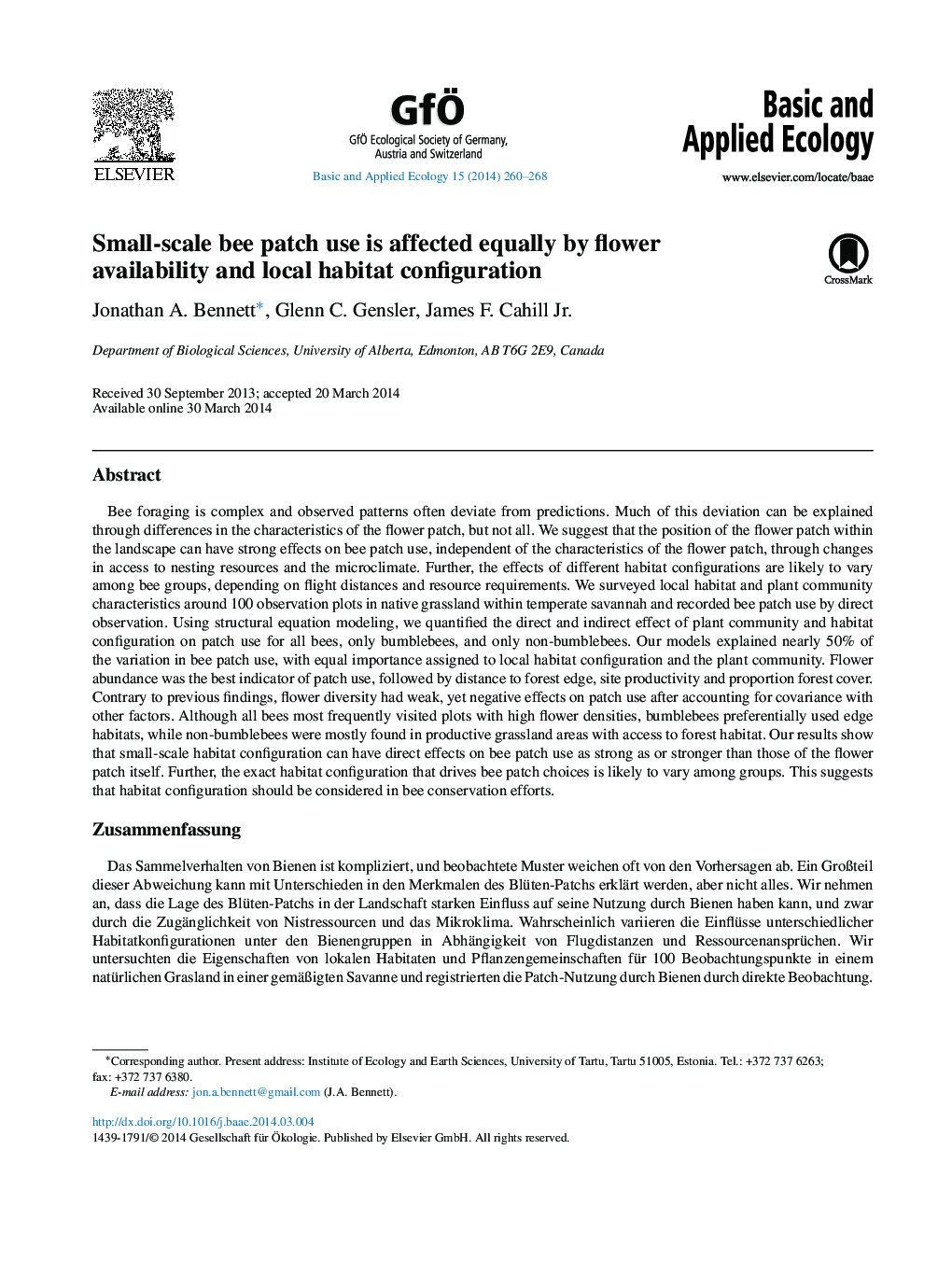| کد مقاله | کد نشریه | سال انتشار | مقاله انگلیسی | نسخه تمام متن |
|---|---|---|---|---|
| 4383897 | 1304373 | 2014 | 9 صفحه PDF | دانلود رایگان |
Bee foraging is complex and observed patterns often deviate from predictions. Much of this deviation can be explained through differences in the characteristics of the flower patch, but not all. We suggest that the position of the flower patch within the landscape can have strong effects on bee patch use, independent of the characteristics of the flower patch, through changes in access to nesting resources and the microclimate. Further, the effects of different habitat configurations are likely to vary among bee groups, depending on flight distances and resource requirements. We surveyed local habitat and plant community characteristics around 100 observation plots in native grassland within temperate savannah and recorded bee patch use by direct observation. Using structural equation modeling, we quantified the direct and indirect effect of plant community and habitat configuration on patch use for all bees, only bumblebees, and only non-bumblebees. Our models explained nearly 50% of the variation in bee patch use, with equal importance assigned to local habitat configuration and the plant community. Flower abundance was the best indicator of patch use, followed by distance to forest edge, site productivity and proportion forest cover. Contrary to previous findings, flower diversity had weak, yet negative effects on patch use after accounting for covariance with other factors. Although all bees most frequently visited plots with high flower densities, bumblebees preferentially used edge habitats, while non-bumblebees were mostly found in productive grassland areas with access to forest habitat. Our results show that small-scale habitat configuration can have direct effects on bee patch use as strong as or stronger than those of the flower patch itself. Further, the exact habitat configuration that drives bee patch choices is likely to vary among groups. This suggests that habitat configuration should be considered in bee conservation efforts.
ZusammenfassungDas Sammelverhalten von Bienen ist kompliziert, und beobachtete Muster weichen oft von den Vorhersagen ab. Ein Großteil dieser Abweichung kann mit Unterschieden in den Merkmalen des Blüten-Patchs erklärt werden, aber nicht alles. Wir nehmen an, dass die Lage des Blüten-Patchs in der Landschaft starken Einfluss auf seine Nutzung durch Bienen haben kann, und zwar durch die Zugänglichkeit von Nistressourcen und das Mikroklima. Wahrscheinlich variieren die Einflüsse unterschiedlicher Habitatkonfigurationen unter den Bienengruppen in Abhängigkeit von Flugdistanzen und Ressourcenansprüchen. Wir untersuchten die Eigenschaften von lokalen Habitaten und Pflanzengemeinschaften für 100 Beobachtungspunkte in einem natürlichen Grasland in einer gemäßigten Savanne und registrierten die Patch-Nutzung durch Bienen durch direkte Beobachtung. Mit Hilfe von Strukturgleichungsmodellen quantifizierten wir die direkten und indirekten Effekte von Pflanzengemeinschaft und Habitatkonfiguration auf die Patch-Nutzung durch alle Bienen, Hummeln und Nicht-Hummeln. Unsere Modelle erklärten fast 50% der Variation der Patch-Nutzung, wobei die lokale Habitatkonfiguration und die Pflanzengesellschaft ungefähr gleiche Bedeutung hatten. Die Blütenabundanz war der beste Indikator der Patch-Nutzung, gefolgt von der Distanz zum Waldrand, Produktivität des Standorts und Wald-Flächenanteil. Im Gegensatz zu früheren Befunden hatte die Blütendiversität schwache, aber negative Effekte auf die Patch-Nutzung, wenn die Kovarianz mit anderen Faktoren berücksichtigt wurde. Auch wenn alle Bienen am häufigsten Standorte mit hoher Blütendichte besuchten, bevorzugten Hummeln Randhabitate, während die Nicht-Hummeln hauptsächlich in produktivem Grasland mit Zugang zum Wald gefunden wurden. Unsere Untersuchungen zeigen, dass die kleinräumige Habitatkonfiguration direkte Auswirkungen auf die Patch-Nutzung durch Bienen haben kann, die so stark oder noch stärker sind als die des Blüten-Patchs selbst. Desweiteren variiert die genaue Habitatkonfiguration, die die Patchwahl der Bienen steuert, wahrscheinlich mit der Bienengruppe. Dies legt nahe, dass die Habitatkonfiguration bei Maßnahmen zum Bienenschutz mitberücksichtigt werden sollte.
Journal: Basic and Applied Ecology - Volume 15, Issue 3, May 2014, Pages 260–268
